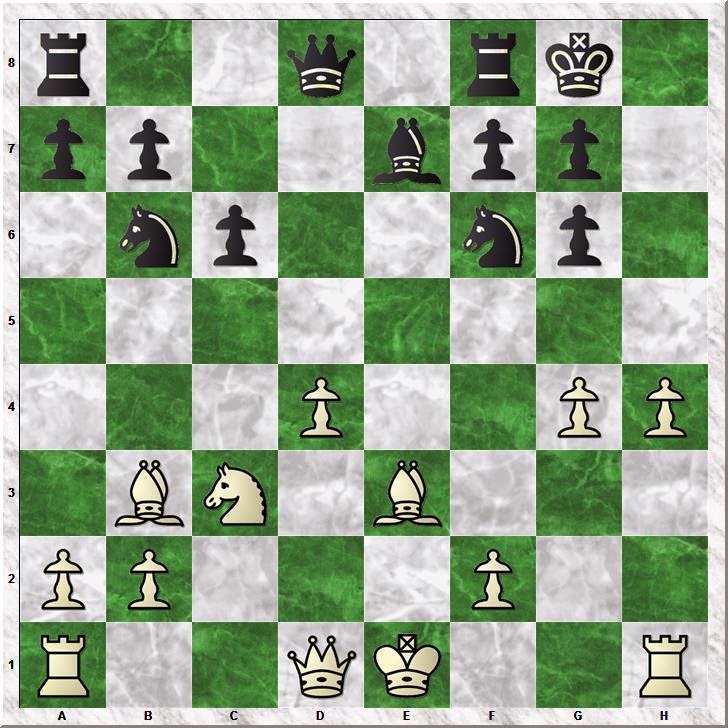McDonnell -- La Bourdonnais 1834
In my series of blog posts on the matches between Alexander McDonnell (1798-1835) and Louis-Charles Mahé de La Bourdonnais (1795-1840), we have reached the eighteenth game of the first match. The match was scheduled for twenty-one games, draws not counting. La Bourdonnais has won the match with eleven wins. McDonnell has two wins and there have been four draws. Nonetheless, they continue the match until completing twenty-one decisive games.
I am going through the games without benefit of engine analysis. There are likely appaling errors in some of my analysis. The series begins with "
Three Fighting Draws" (June 2014) and I discuss game seventeen in "
Mating Attack".
In game eighteen, McDonnell again adopts the King's Bishop's Gambit as he had in game eleven (see "
Losing Takes a Toll"). This opening would develop a strong reputation over the next several decades, although it is rarely played today. Adolf Anderssen's "Immortal Game" began as a King's Bishop's Gambit.
McDonnell,Alexander -- De Labourdonnais,Louis Charles Mahe [C33]
London m1 London (18), 1834
1.e4 e5 2.f4 exf4 3.Bc4 Qh4+ 4.Kf1 g5 5.Nc3 Bg7 6.d4 Nc6
An unusual move. More common is6...Ne7. One notable game continued 7.g3 fxg3 8.Kg2 d6 9.hxg3 Qg4 10.Qxg4 Bxg4 11.Bxg5 Capablanca,J--Allies, Philadelphia 1910. It ended as a draw in 29 moves.
La Bourdonnais played 6...d6 in three other games in these matches.
White to move
7.e5
McDonnell's move is unique in the ChessBase database. It removes f6 from the undeveloped Black knight, but opens f5 for the same. This move also has the consequence that Black's d-pawn cannot be captured on d5. This move opens e4 for a White knight, which McDonnell will use soon.
The immediate 7.Nf3 is probably a better move. Play might continue 7...Qh5 8.Nd5 Kd8 9.Be2 Qg6 10.Nxg5 Qxg5 11.Bxf4 Qg6 12.Bxc7+ Ke8 13.Bh5 Qe6 14.Bg3 Nagibin,G (2392)--Logashov,S (2325) Moscow 2009. White won in 43 moves.
7...Nge7 8.Nf3 Qh5 9.Ne4 h6
White to move
10.Nf6+
McDonnell might have prepared his attack with 10.Qe2 Nf5
Here I looked at two ways to proceed:
a) 11.Nf6+ Bxf6 12.exf6+ Kd8 13.c3
b) 11.Nd6+ Nxd6 12.exd6+ Kd8 13.d5 (13.dxc7+ Kxc7 14.c3) 13...Ne5 14.Nxe5 Qxe2+ 15.Bxe2 Bxe5 16.dxc7+
He also might have tried 10.c3 Nf5 11.Kf2.
I am not certain if any of these lines are better than McDonnell's play in the game.
10...Bxf6 11.exf6 d5 12.Bd3 Nf5 13.Qe1+
13.c3 is an interesting alternative, which La Bourdonnais could meet with the simple 13... 0–0 or the double-edged 13...Ng3+!? 14.Kg1 Nxh1 15.Qe2+ Be6 16.Bf5 0–0 17.Bxe6 fxe6 18.Qxe6+ Kh7 19.Qf5+ Kh8 20.Bxf4! Here White appears to have compensation for the sacrificed material.
 |
| Analysis diagram after 20.Bxf4 |
13...Kd8 14.Ne5
14.c3 Ng3+
14...Nfxd4
14...Ng3+ 15.Kg1 Nxh1 16.Nxc6+ bxc6? 17.Qe7#.
15.c3 Nxe5 16.Qxe5 Nc6 17.Qxd5+ Ke8
White to move
18.Bb5
18.Bxf4!?
McDonnell missed a simple pin, or he rejected it for the gain of material in the game.
18...Be6 19.Re1.
18...Be6 19.Bxc6+ Kf8 20.Qc5+ Kg8 21.Bf3 Qg6
White has more material on the board, but how will the rooks come into play? How will the dark-squared bishop participate in the battle?
22.Qd4?
The effort to defend the f-pawn proves costly. This move seems to me to be McDonnell's critical error.
22.Bd2 seems better to me with at least three ways for Black to proceed:
a) 22...Qxf6 23.Re1.
b) 22...b6 23.Qf2 Rd8 24.Rd1 g4 25.Bc6 Qxf6.
c) 22...Qd3+ 23.Ke1 Rd8 24.Qf2 g4 25.Bxb7.
White's chances seem to me better in each of these lines than they were in the game, although Black has seized the initiative in each case. White retains material superiority and may be able to defend against Black's counterattack.
22...c5 23.Qe5 Re8
White to move
24.Be2
Perhaps 24.Kf2 was necessary. Black's response might have been 24...Bd7 25.Qd5 Bc6 26.Qd2.
24...f3! 25.Kf2
25.Bxf3 Bc4+ 26.Kf2 Rxe5 and Black wins.
25...fxe2 26.Be3 b6 27.h4
27.Rhe1 Bd7 28.Qc7 Qf5+ 29.Kg1 Rxe3 and Black wins.
27...Bd7 28.Qd5 Qxf6+ 29.Kxe2 Bg4+ 30.Kd2 Rd8 0–1
White's attack fell short, although he recovered the pawn sacrificed in the opening. McDonnell showed that he could achieve material superiority through tactics, but he then faltered.
McDonnell's long sequences of losses, interrupted only by a single draw, would
end with the next game. The contestants would alternate wins--always with the Black pieces--until La Bourdonnais would win with White in the final game of the first match.











































